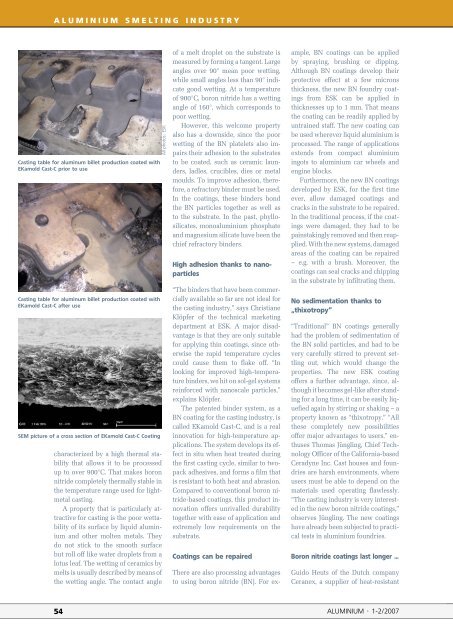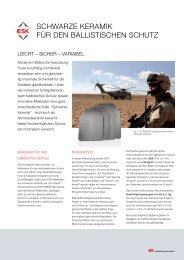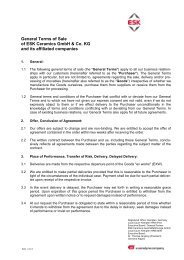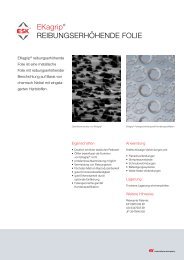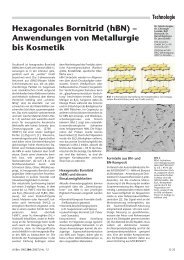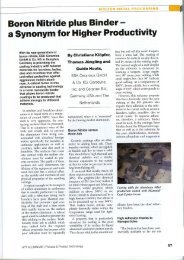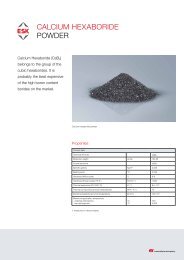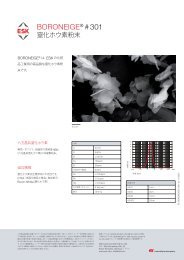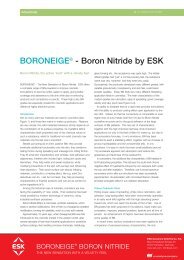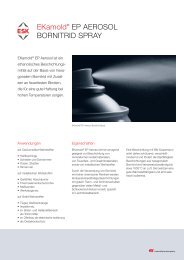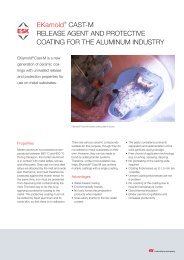Boron nitride plus binder â a synonym for higher productivity
Boron nitride plus binder â a synonym for higher productivity
Boron nitride plus binder â a synonym for higher productivity
You also want an ePaper? Increase the reach of your titles
YUMPU automatically turns print PDFs into web optimized ePapers that Google loves.
ALUMINIUM SMELTING INDUSTRY<br />
Casting table <strong>for</strong> aluminum billet production coated with<br />
EKamold Cast-C prior to use<br />
Casting table <strong>for</strong> aluminum billet production coated with<br />
EKamold Cast-C after use<br />
SEM picture of a cross section of EKamold Cast-C Coating<br />
characterized by a high thermal stability<br />
that allows it to be processed<br />
up to over 900°C. That makes boron<br />
<strong>nitride</strong> completely thermally stable in<br />
the temperature range used <strong>for</strong> lightmetal<br />
casting.<br />
A property that is particularly attractive<br />
<strong>for</strong> casting is the poor wettability<br />
of its surface by liquid aluminium<br />
and other molten metals. They<br />
do not stick to the smooth surface<br />
but roll off like water droplets from a<br />
lotus leaf. The wetting of ceramics by<br />
melts is usually described by means of<br />
the wetting angle. The contact angle<br />
All photos: ESK<br />
of a melt droplet on the substrate is<br />
measured by <strong>for</strong>ming a tangent. Large<br />
angles over 90° mean poor wetting,<br />
while small angles less than 90° indicate<br />
good wetting. At a temperature<br />
of 900°C, boron <strong>nitride</strong> has a wetting<br />
angle of 160°, which corresponds to<br />
poor wetting.<br />
However, this welcome property<br />
also has a downside, since the poor<br />
wetting of the BN platelets also impairs<br />
their adhesion to the substrates<br />
to be coated, such as ceramic launders,<br />
ladles, crucibles, dies or metal<br />
moulds. To improve adhesion, there<strong>for</strong>e,<br />
a refractory <strong>binder</strong> must be used.<br />
In the coatings, these <strong>binder</strong>s bond<br />
the BN particles together as well as<br />
to the substrate. In the past, phyllosilicates,<br />
monoaluminium phosphate<br />
and magnesium silicate have been the<br />
chief refractory <strong>binder</strong>s.<br />
High adhesion thanks to nanoparticles<br />
“The <strong>binder</strong>s that have been commercially<br />
available so far are not ideal <strong>for</strong><br />
the casting industry,” says Christiane<br />
Klöpfer of the technical marketing<br />
department at ESK. A major disadvantage<br />
is that they are only suitable<br />
<strong>for</strong> applying thin coatings, since otherwise<br />
the rapid temperature cycles<br />
could cause them to flake off. “In<br />
looking <strong>for</strong> improved high-temperature<br />
<strong>binder</strong>s, we hit on sol-gel systems<br />
rein<strong>for</strong>ced with nanoscale particles,”<br />
explains Klöpfer.<br />
The patented <strong>binder</strong> system, as a<br />
BN coating <strong>for</strong> the casting industry, is<br />
called EKamold Cast-C, and is a real<br />
innovation <strong>for</strong> high-temperature applications.<br />
The system develops its effect<br />
in situ when heat treated during<br />
the first casting cycle, similar to twopack<br />
adhesives, and <strong>for</strong>ms a film that<br />
is resistant to both heat and abrasion.<br />
Compared to conventional boron <strong>nitride</strong>-based<br />
coatings, this product innovation<br />
offers unrivalled durability<br />
together with ease of application and<br />
extremely low requirements on the<br />
substrate.<br />
Coatings can be repaired<br />
There are also processing advantages<br />
to using boron <strong>nitride</strong> (BN). For ex-<br />
ample, BN coatings can be applied<br />
by spraying, brushing or dipping.<br />
Although BN coatings develop their<br />
protective effect at a few microns<br />
thickness, the new BN foundry coatings<br />
from ESK can be applied in<br />
thicknesses up to 1 mm. That means<br />
the coating can be readily applied by<br />
untrained staff. The new coating can<br />
be used wherever liquid aluminium is<br />
processed. The range of applications<br />
extends from compact aluminium<br />
ingots to aluminium car wheels and<br />
engine blocks.<br />
Furthermore, the new BN coatings<br />
developed by ESK, <strong>for</strong> the first time<br />
ever, allow damaged coatings and<br />
cracks in the substrate to be repaired.<br />
In the traditional process, if the coatings<br />
were damaged, they had to be<br />
painstakingly removed and then reapplied.<br />
With the new systems, damaged<br />
areas of the coating can be repaired<br />
– e.g. with a brush. More ov er, the<br />
coatings can seal cracks and chipping<br />
in the substrate by infiltrating them.<br />
No sedimentation thanks to<br />
„thixotropy“<br />
“Traditional” BN coatings generally<br />
had the problem of sedimentation of<br />
the BN solid particles, and had to be<br />
very carefully stirred to prevent settling<br />
out, which would change the<br />
properties. The new ESK coating<br />
offers a further advantage, since, although<br />
it becomes gel-like after standing<br />
<strong>for</strong> a long time, it can be easily liquefied<br />
again by stirring or shaking – a<br />
property known as “thixotropy.” “All<br />
these completely new possibilities<br />
offer major advantages to users,” enthuses<br />
Thomas Jüngling, Chief Technology<br />
Officer of the Cali<strong>for</strong>nia-based<br />
Ceradyne Inc. Cast houses and foundries<br />
are harsh environments, where<br />
users must be able to depend on the<br />
materials used operating flawlessly.<br />
“The casting industry is very interested<br />
in the new boron <strong>nitride</strong> coatings,”<br />
observes Jüngling. The new coatings<br />
have already been subjected to practical<br />
tests in aluminium foundries.<br />
<strong>Boron</strong> <strong>nitride</strong> coatings last longer …<br />
Guido Heuts of the Dutch company<br />
Ceranex, a supplier of heat-resistant<br />
54 ALUMINIUM · 1-2/2007


